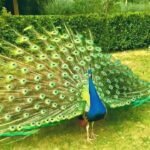Table of Contents
Peacock Dance: An Overview Peacocks are renowned for their mesmerizing dance, which is actually a part of their courtship ritual. This elaborate display is a sight to behold, as the male peacock fans out his stunning iridescent tail feathers and performs an intricate dance to woo a potential mate. Let’s dive into the world of peacock dance and learn more about their captivating performances, the significance of their feathers, and the cultural impact of this spectacular phenomenon.
Peacock Dance Video
Finding the Best Videos Thanks to the internet, you can now watch peacock dance videos from the comfort of your home. Platforms like YouTube and Vimeo offer a plethora of videos showcasing the elegant dance moves of these majestic birds. From wildlife documentaries to personal recordings by bird enthusiasts, you’ll find a wide variety of content to satisfy your curiosity.
The Science Behind the Dance Peacock dance videos not only provide a visual treat, but they also offer a fascinating look into the science behind this behavior. Researchers have discovered that the vibrations created by the peacock’s feathers during the dance produce low-frequency sounds, which play a crucial role in attracting a mate. So, it’s not just the stunning visuals that make this dance effective – it’s also the sounds that accompany it.
Peacock Feathers
Colors and Patterns The peacock’s vibrant tail feathers, also known as train feathers, are undoubtedly its most striking feature. The iridescent colors displayed are a result of microscopic structures within the feathers that interact with light, creating an array of dazzling hues. Moreover, the intricate patterns, or “eyes,” found on the feathers are thought to further enhance the visual display during the dance.
Symbolism and Significance Throughout history, peacock feathers have been revered for their beauty and used as symbols of royalty, divinity, and immortality. In various cultures, they are believed to bring good luck, protect against evil, and represent spiritual awakening. Their widespread appeal has led to the incorporation of peacock motifs in fashion, art, and home décor.
Peacock Dancing
Courtship Rituals The primary purpose of the peacock’s dance is to attract a mate. When a male peacock senses the presence of a female, he begins his performance by raising and fanning out his train feathers. He then proceeds to shake and rattle his feathers, creating a captivating display of colors, patterns, and sounds. The female evaluates the male’s dance, and if she is impressed, she will mate with him.
Peacock Dance in Culture
Indian Classical Dance The peacock dance has long been a source of inspiration for various forms of dance, especially in Indian classical dance forms. The grace and beauty of the peacock’s movements are often replicated by dancers in styles such as Bharatanatyam and Kuchipudi. These dance forms incorporate peacock-inspired costumes and movements, paying homage to the elegance of the bird and its cultural significance in India.
The Green Peafowl of Southeast Asia While the Indian Peafowl (Pavo cristatus) is the most well-known species, the Green Peafowl (Pavo muticus) native to Southeast Asia also displays an impressive dance. Their courtship rituals share similarities with their Indian counterparts, but the Green Peafowl sports a more vibrant color palette, featuring iridescent green and blue hues. Their dance is equally captivating and holds cultural significance in the region.
Conclusion
The peacock’s dance is an awe-inspiring display of beauty and courtship. From the intricacies of their feathers to the captivating performances that have inspired various art forms, peacocks continue to captivate our imagination. As you explore the world of peacock dance videos, take a moment to appreciate the wonders of nature and the cultural impact of these magnificent birds.
FAQs
1. Why do peacocks dance?
Peacocks dance for mating. The male peacock impresses women with his tail feathers and elaborate dancing routines.
2. Can all peacocks fan out their feathers and dance?
Only male peacocks, called peafowls, dance. Peahens, or female peacocks, do not do this.
3. How do peacock feathers get their vibrant colors?
Peacock feathers are iridescent due to microscopic features that interact with light.
4. Are there different species of peacocks?
The Indian, Green, and Congo peacocks are the principal species. Indian and Green Peafowls have amazing courtship dances.
5. What is the cultural significance of peacock dance in India?
Bharatanatyam and Kuchipudi are influenced by the peacock dance. The Indian national bird, the peacock, symbolises elegance, grace, and spirituality.







